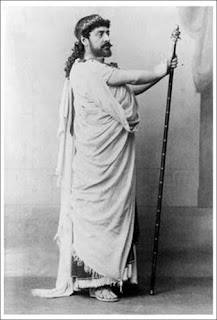10. Serenus the Gardener (Feb 23)
Serenus was your basic hermit, but he also had quite a garden, with which he supported himself. One day, he was visited by the wife of one of the imperial guard, but basically told her to skedaddle (she may have come onto him – accounts differ). He got in trouble for this, but was able to explain himself. In so doing, however, he also gave away that he was a Christian and, for this, was subsequently martyred.
“Go on, get outta here!”
Fittingly, Serenus is the patron saint of gardeners, but also of the falsely accused. All of this happened around the year 300, in what is now modern-day Serbia.
9. Margaret of Cortona (Feb 22)
Patronage: hoboes
There are a surprising number of patron saints for those who ride the rails. In addition to Margaret, we’ve also got:
- Benedict Joseph Labre
- Edwin of Northumbria
- Elizabeth of Hungary
- Lufthild
Margaret was something of a Mary Magdalene figure. She was some guy’s mistress for a number of years, and had a child out of wedlock with him, before seeing the light. An attractive woman, she was still pursued – and occasionally succumbed – even after her conversion experience.
Free on Amazon Kindle
Eventually, Margaret formed her own community (called the Poverelle, or “poor little things”), which ministered to the sick. She never, though, truly lived down her previous life.
Cortona? It’s in Tuscany. Hoboes? I’m not totally sure.
8. Émilie d’Oultremont d’Hoogvorst (Feb 22)
As if that wasn’t bad enough, Emilie is also known as Baroness Émilie d’Oultremont van der Linden d’Hooghvorst.
The daughter of a Belgian count, Emilie would subsequently marry a Belgian baron. Widowed before she turned 30, she would then enter religious life and also found her own order.
All of this happened in the 19th Century. And that means we have actual photographs of her.
7. Ludwig Mzyk (Feb 23)
Short, sweet, and totally unpronounceable …
Ludwig is another recent saint – living, in fact, in the 20th Century. Ludwig was born in 1905, in Poland, to a poor family in a coal-mining district. After becoming a priest, he would be placed in charge of novitiates (priests in training).
He was martyred by the Nazis in World War II.
6. Praetextatus of Rouen (Feb 24).
This guy sounds more like a politician than a saint. First, he gets himself exiled as Bishop of Rouen for political intrigue and “fomenting rebellion.” He is then reinstated as bishop, gets in hot water with the queen, and subsequently gets assassinated by her.
“You! You did this to me!”
In addition to Pratextatus, the cast of characters for this drama includes such great names as Chilperic, Brunhilda, Guntrim, and Fredegund. Interestingly, Pratextatus usually went by the much shorter “Prix.”
All of this took place in 6th Century France, by the way.
5. Caesarius of Nanzianzen (Feb 25)
Patronage: bachelors
Geez, couldn’t this be just about any male saint?
Caesarius was not your typical 4th Century saint. He was physician at the Byzantine court and a politician as well (quaestor of Bythnia, no less). In fact, this pretty worldly guy was only baptized (and decided to give up the world) right before his death.
He did, however, have some major family connections. His brother was the well-known and very holy Gregory Nazianzen. His father, Gregory the Elder, and mother, Nonna, were saints as well. Oh, sis Gorgona got in on the saintly act too. Heck, can’t leave out Caesarius now, can we?
4. Callistus Caravario (Feb 25)
Astonishingly awesome alliteration.
Another 20th Century saint, Callistus was a Salesian missionary, in China. He was killed, along with his bishop, by “Bolshevik pirates who planned to abduct and enslave the girls on [his] ship.” He was less than 30 years old.
I don’t know why, but I always get a kick out of seeing photos of real, live saints:
3. Walburga (Feb 25)
Patronage: against mad dogs
So, should I assume that there’s some other saint out there who is for mad dogs?
Does that name sound familiar? This one is also known as Walpurgis, and the eve of her holy day is called Walpurgis Night. And that’s when witches traditionally get together.
Happy Walpurgis Night, everybody!
Now that last fact actually has nothing to do with Walburga. Her feast day simply used to be on May 1, a day that was traditionally associated with pagan celebrations of Spring.
Walburga herself was born in England, but later migrated to Germany to convert the still-pagan Germans. She was an abbess, author, and miracle worker.
She, too, came from a very religious family. Her father was St. Richard the Pilgrim, a minor Saxon royal; her mother was the sister of the fairly well-known St. Boniface; and her two brothers, the wonderfully named Winibald and Willibald, would become saints as well.
2. Polycarp of Smyrna (Feb 22)
Patronage: against dysentery
I guess some patronages are a little more glamorous than others …
Polycarp was a disciple of John the Apostle. He was a 2nd Century bishop and martyr.
Early hound’s tooth?
As for the diarrhea? I haven’t a clue. And neither does this blogger, though he does have a good suggestion:
And finally, my personal favorite, St. Polycarp, the patron siant of diarrhea. Typical martyr story, he was burned at the stake but didn’t die, so they had to stab him with daggers. Why he gets the dubious honor of patron saint of massive colon blowouts is a mystery. As we know, the Lord works in mysterious ways, and Catholicism in out-right weird ways. But what an easy costume to assemble. A white toga with strategically placed brown stains. Done.
By the way, “Polycarp” means “much fruit,” in Greek.
1. Alexander of Alexandria (Feb 26)
Of the Alexandria Alexanders …
Alexander was a 4th Century pope, but – interestingly – not a pope of Rome. He was a pope of Alexandria, of the See of St. Mark. Personally, I actually had no idea there were any other popes.
Turns out these popes are actually still around, as head of the Coptic Church. And the Catholic Church recognizes them as popes as well.
Looks like he and Polycarp shop at the same store
Alexander was one of the leading early fathers of the church. He devoted a lot of his time battling Arianism (he personally excommunicated Arias) and played an important role at the Council of Nicaea.
Honorable Mention
- Cumine the White
- Nestor of Side
- Milburga
- Alnoth
- Papias of Heirapolis
- Lazarus Zographos
- Zebinus of Syria
- Mark Barkworth
- Pupulus of Alexandria
- Procopius of Decapolis




































